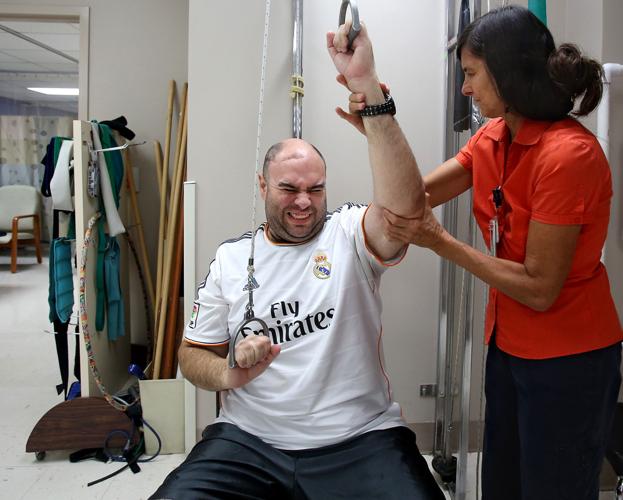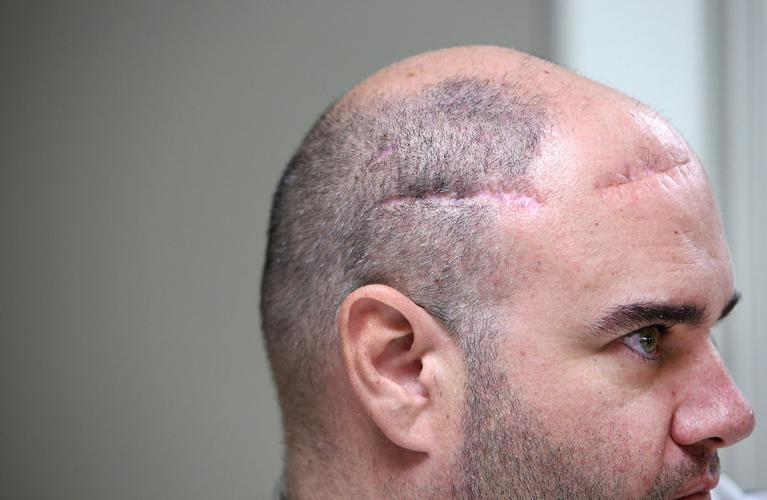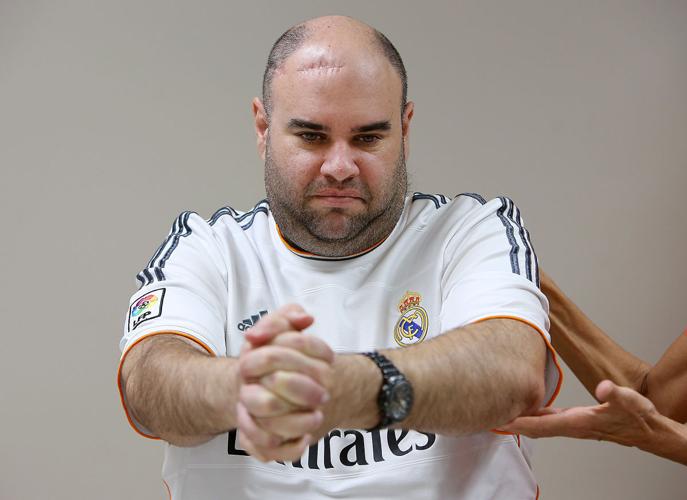Tucson Rural/Metro Capt. Eric Cline takes a penny off the table with his left hand and tries piling it on top of another penny. He misses.
He tries again. Another miss.
“A little frustrating?” asks occupational therapist assistant Breeze Cudzilo.
“Yeah, it is,” answers Cline, 40, shaking his head and looking down at the table during his regular twice weekly therapy at HealthSouth Rehabilitation in Tucson.
The veteran firefighter on March 26 suffered a devastating and unexpected ruptured aneurysm that nearly killed him.
Cline now has what’s often known as “left side neglect” — he forgets about the left side of his body because of the damage that the rupture and a subsequent stroke caused to the right side of his brain.
That means the father of three young children limps, and his left arm sometimes hangs at his side. He doesn’t always notice when someone is standing to his left, and when he reads, he often forgets the left side of words and sentences.
In his family’s apartment, he has a habit of bumping his left side into the kitchen counter.
And he’s sensitive to noise, which makes home life trying at times, since his children range in age from 15 months to 7 years old.
“Walk away, take a deep breath and then come back,” Cudzilo advises Cline as a way of coping.
LONG ROAD BACK
While Cline still struggles, he’s also made significant progress.
About 30,000 people in the United States suffer a ruptured aneurysm per year, which works out to about 100 annually in the Tucson area. In nearly half of all cases, the rupture is fatal.
An aneurysm is a bulging, weakened area in the middle layer of the wall of a blood vessel, resulting in an abnormal widening. When the blood vessel wall gets too weak, the aneurysm bursts and bleeds into the area around the brain.
Most ruptured aneurysms occur in older people. The chances were extremely slim — less than one-half of 1 percent — that Cline would have an aneurysm burst at the age of 40.
When his aneurysm burst, his prognosis was terrible. He was hospitalized at Tucson Medical Center and firefighters from across town held vigil for him on that night. His eyes were unresponsive, and he had no reaction to pain. It appeared he might be brain dead. Cline’s fellows and his family prepared to say goodbye.
“The doctor talked to us about organ donation,” said his wife, Risa Cline, 34.
But just as his family was trying to accept the worst, Cline coughed and began reacting to touch.
Two surgeries later, he was still alive and saying a few words, but no one knew about long-term deficits. When he moved from the hospital to HealthSouth Rehabilitation on April 24, it took three people plus a Hoyer lift to get him in and out of bed.
Cline spent six weeks as an inpatient at HealthSouth, gradually regaining movement and speech. Physically, he has gone from being carried to using a wheelchair to using a walker to now walking with a limp, though he still uses the walker for long outings.
While his long-term memory has been largely unaffected, his short-term memory comes and goes.
“It was like ‘50 First Dates’,” Risa said, referring to the 2004 movie about a character played by Drew Barrymore who has no short-term memory.
“Every day he woke up and said, ‘Where am I?’”
He told Risa recently that he remembered seeing the movie “Insurgent”, which they watched on March 26, shortly before his aneurysm burst. But during a different conversation a few days later, he told Risa that he had no memories of “Insurgent” at all.
“I lose focus easily. I have the attention span of a gnat lately,” Cline tells speech language pathologist Heather Talag as he struggles to read aloud a paragraph she’s put in front of him, using a pen to guide himself across each word.
“Set yourself tangible goals,” Talag tells him. “It takes a lot of re-training.”
Talag puts a vertical red line down the left side of the page.
“You need to bring your pen to that red line every time,” she says. “It’s like practicing piano. We’re trying to find strategies that make the processes easier. Consistent use of the strategies is what’s going to get you through your daily life.”
IT’S ABOUT RECOVERY
Eric and Risa are spending a lot more time together than before the aneurysm.
“Even little things like going to the grocery store are a big deal,” Risa said. “He can’t be left alone because he’s a fall risk. He doesn’t have all his judgment skills.”
When Risa is not with Cline, his parents are.
He remains optimistic and wants to go back to firefighting, maybe early next year. He’s been an outpatient at HealthSouth since June 10.
Risa, who has taken a leave from her own job at her family’s preschool business, is more measured.
“It’s been a learning curve and it still is,” Risa said. “It’s not all about going back to work. It’s about recovery.”







